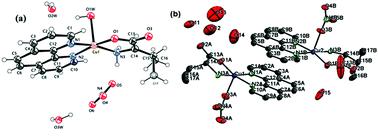当前位置:
X-MOL 学术
›
Dalton Trans.
›
论文详情
Our official English website, www.x-mol.net, welcomes your
feedback! (Note: you will need to create a separate account there.)
Copper(ii) l/d-valine-(1,10-phen) complexes target human telomeric G-quadruplex motifs and promote site-specific DNA cleavage and cellular cytotoxicity.
Dalton Transactions ( IF 3.5 ) Pub Date : 2020-06-23 , DOI: 10.1039/d0dt01527j Farukh Arjmand 1 , Surbhi Sharma 1 , Sabiha Parveen 1 , Loic Toupet 2 , Zhen Yu 3 , James Allan Cowan 3
Dalton Transactions ( IF 3.5 ) Pub Date : 2020-06-23 , DOI: 10.1039/d0dt01527j Farukh Arjmand 1 , Surbhi Sharma 1 , Sabiha Parveen 1 , Loic Toupet 2 , Zhen Yu 3 , James Allan Cowan 3
Affiliation

|
Chiral L-/D-valine-(1,10-phen)-Cu(II) complexes that target G-quadruplex DNA were synthesized and thoroughly characterized by UV-vis, IR, EPR, ESI-MS, elemental analysis and single crystal X-ray spectroscopy. Complexes 1a and 1b crystallized in the monoclinic P21/c and C2 space groups, respectively. On the basis of Wolfe–Shimer analyses, the binding affinities of 1a and 1b with G-quadruplex telomeric DNA were determined, and 1a exhibited significantly higher binding as compared to 1b. Site selective cleavage of G4-DNA was demonstrated by employing the time-dependent PAGE assay, with 1a exhibiting a significantly higher cleavage rate from A1 to G22 (4.32 (±0.13) μM h−1) than 1b (4.29 (±0.11) μM h−1). The DNA cleavage profile demonstrated that both complexes perform non-random double-strand cleavage by following first-order kinetics (kobs = 0.9432 min−1 for 1a and kobs = 0.6574 min−1 for 1b). Molecular docking simulations were performed with both parallel and anti-parallel topologies of the quadruplex to provide a clear insight on G-quadruplex-complex interactions. Complexes 1a and 1b were found to interact strongly at the minor groove cavity of the quadruplex with preferential selectivity for the parallel vs. anti-parallel quadruplex. The cytotoxic activities of complexes 1a and 1b were evaluated on a few notably important human cancer cell lines, viz, breast (MCF-7), pancreatic strains (BxPC3, AsPC1) and liver (Huh7) by an MTT assay. Both 1a and 1b exhibited pronounced cytotoxic activity with remarkably low IC50 values (1–3 μM) for all tested cancer strains.
中文翻译:

Copper(ii) l/d-valine-(1,10-phen) 复合物靶向人类端粒 G-四链体基序并促进位点特异性 DNA 切割和细胞毒性。
合成了靶向 G-四链体 DNA 的手性L -/ D -缬氨酸-(1,10-phen)-Cu( II ) 复合物,并通过 UV-vis、IR、EPR、ESI-MS、元素分析和单晶进行了彻底表征X射线光谱学。配合物1a和1b分别在单斜晶系P 21/ c和C 2 空间群中结晶。根据 Wolfe-Shimer 分析,确定了1a和1b与 G-四链体端粒 DNA 的结合亲和力,并且1a与1b相比表现出明显更高的结合力。G4-DNA 的位点选择性裂解通过采用时间依赖性 PAGE 测定来证明,1a表现出从 A1 到 G22 的裂解率 (4.32 (±0.13) μM h -1 )明显高于1b (4.29 (±0.11) μM) h -1 )。DNA 切割谱表明,两种复合物均按照一级动力学进行非随机双链切割(1a的k obs = 0.9432 min -1,1b的k obs = 0.6574 min -1)。使用四链体的平行和反平行拓扑进行分子对接模拟,以提供对 G-四链体-复合物相互作用的清晰了解。发现配合物1a和1b在四联体的小沟腔处强烈相互作用,并且对平行四联体与反平行四联体具有优先选择性。通过 MTT 测定,评估了复合物1a和1b对一些特别重要的人类癌细胞系,即乳腺癌 (MCF-7)、胰腺株 (BxPC3、AsPC1) 和肝脏 (Huh7)的细胞毒活性。对于所有测试的癌症菌株,1a和1b均表现出显着的细胞毒活性,且 IC 50值极低(1–3 μM)。
更新日期:2020-07-21
中文翻译:

Copper(ii) l/d-valine-(1,10-phen) 复合物靶向人类端粒 G-四链体基序并促进位点特异性 DNA 切割和细胞毒性。
合成了靶向 G-四链体 DNA 的手性L -/ D -缬氨酸-(1,10-phen)-Cu( II ) 复合物,并通过 UV-vis、IR、EPR、ESI-MS、元素分析和单晶进行了彻底表征X射线光谱学。配合物1a和1b分别在单斜晶系P 21/ c和C 2 空间群中结晶。根据 Wolfe-Shimer 分析,确定了1a和1b与 G-四链体端粒 DNA 的结合亲和力,并且1a与1b相比表现出明显更高的结合力。G4-DNA 的位点选择性裂解通过采用时间依赖性 PAGE 测定来证明,1a表现出从 A1 到 G22 的裂解率 (4.32 (±0.13) μM h -1 )明显高于1b (4.29 (±0.11) μM) h -1 )。DNA 切割谱表明,两种复合物均按照一级动力学进行非随机双链切割(1a的k obs = 0.9432 min -1,1b的k obs = 0.6574 min -1)。使用四链体的平行和反平行拓扑进行分子对接模拟,以提供对 G-四链体-复合物相互作用的清晰了解。发现配合物1a和1b在四联体的小沟腔处强烈相互作用,并且对平行四联体与反平行四联体具有优先选择性。通过 MTT 测定,评估了复合物1a和1b对一些特别重要的人类癌细胞系,即乳腺癌 (MCF-7)、胰腺株 (BxPC3、AsPC1) 和肝脏 (Huh7)的细胞毒活性。对于所有测试的癌症菌株,1a和1b均表现出显着的细胞毒活性,且 IC 50值极低(1–3 μM)。











































 京公网安备 11010802027423号
京公网安备 11010802027423号